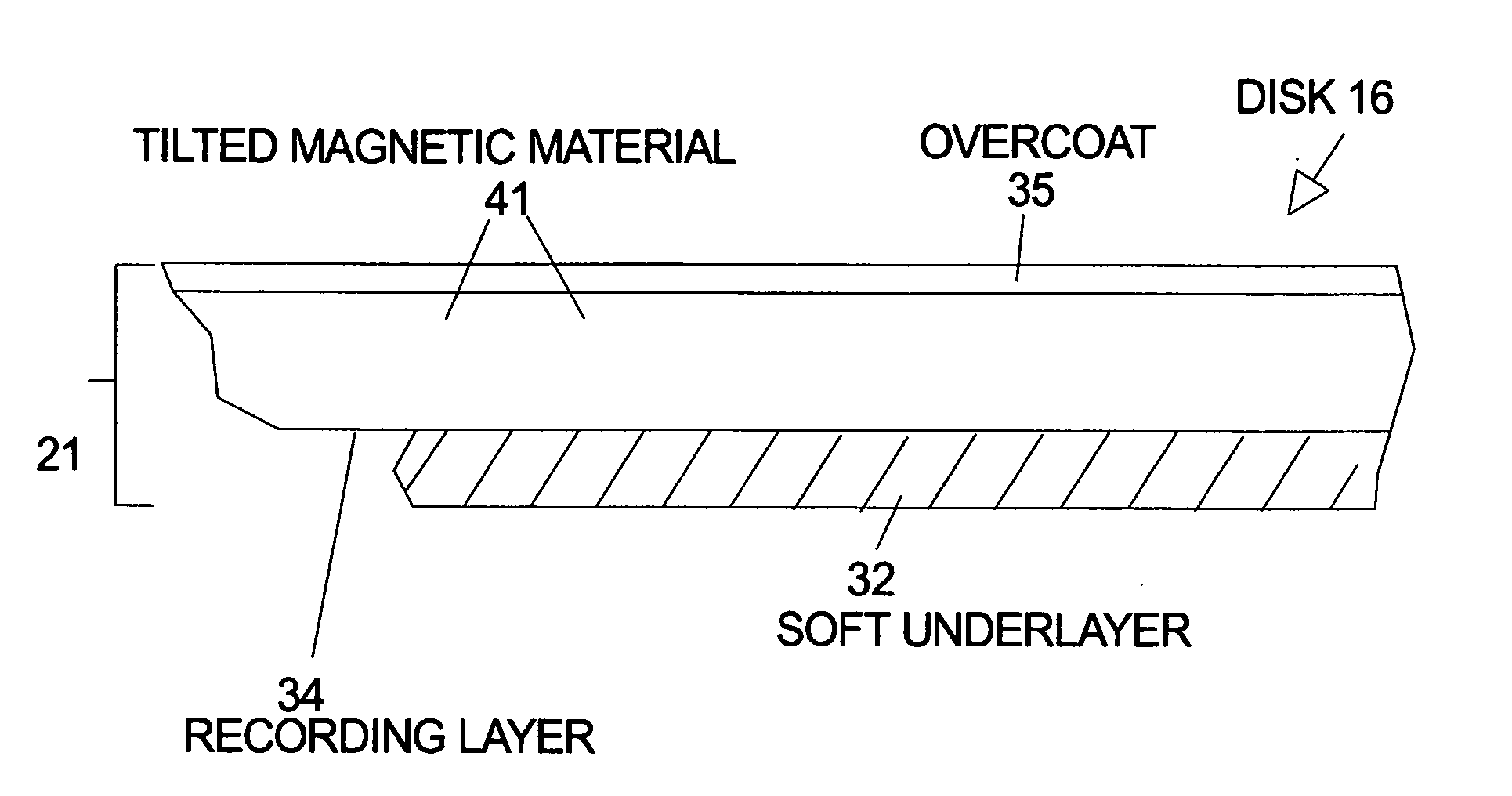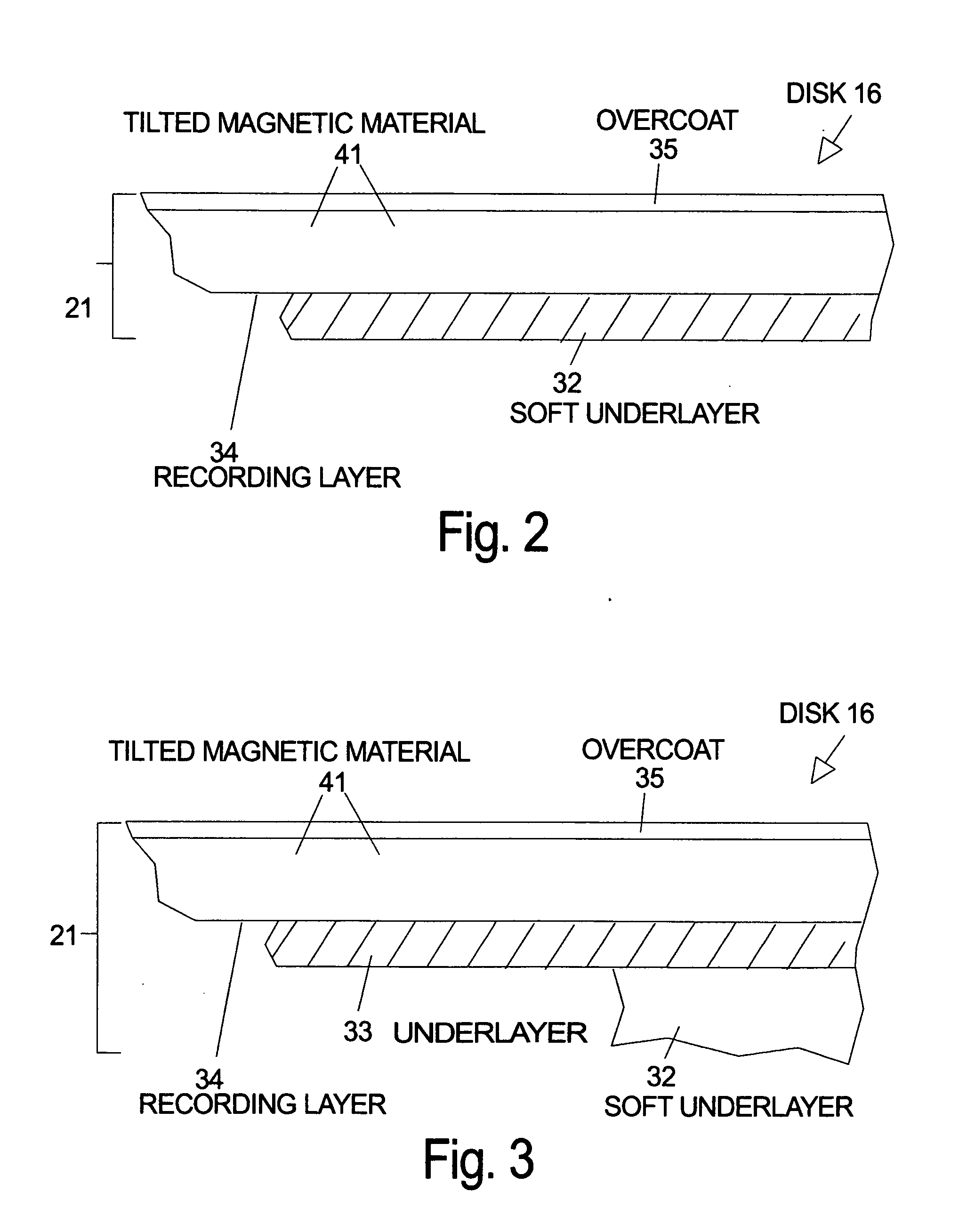Magnetic recording media for tilted recording
a recording media and magnetic recording technology, applied in the field of magnetic storage devices and magnetic recording media, can solve the problems of not giving materials or techniques, and the expected cost of tilted recording devices is about the same as currently available technologies
- Summary
- Abstract
- Description
- Claims
- Application Information
AI Technical Summary
Benefits of technology
Problems solved by technology
Method used
Image
Examples
first embodiment
[0023] the invention is illustrated in FIG. 2 which shows a section of the thin films 21 on a disk 16 for according to an embodiment of the invention. The recording layer 34 comprises (111) oriented, granular L10 magnetic material 41 deposited over a soft underlayer (SUL) 32 for the purpose of tilted recording with a perpendicular write field. The magnetic properties of the recording layer 34 are selected to provide an easy axis of switching (anisotropy) which is tilted out of the plane of the thin films on the surface of the disk. The magnetic easy axis of the magnetic material is approximately 36 degrees out the plane of the film. The thicknesses of the films in the drawings are not according to scale. The actual thicknesses can be determined according to the prior art except where noted herein. Preferably the L10 recording layer thickness is less than 20 nm and the distance between the bottom of the L10 media and top of the SUL is less than 20 nm. The average grain size in the pl...
second embodiment
[0028] the invention is illustrated in FIG. 3 which shows a section of the thin films 21 on a disk 16 with an intermediate layer 33 deposited between the recording layer 34 and SUL 32. The intermediate layer material is chosen to have close lattice matching to the L10 film. In one embodiment the invention includes a lattice-matched fcc metal layer with (111) texture as an intermediate layer for epitaxial L10 tilted media. For example, CoPt has a-axis lattice constant of 3.80 angstroms and c-axis lattice constant of 3.68 angstroms while FePt has a=3.85 angstroms and c=3.71 angstroms. Fcc metals that are well lattice-matched include platinum (a=c=3.92 angstroms), palladium (a=c=3.89 angstroms), iridium (a=c=3.84 angstroms), and rhodium (a=c=3.80 angstroms). Alternatively, hcp metals with (100) texture have a triangular close-packed surface structure and can also be used to establish the epitaxy for (111) oriented L10 tilted media. For example, ruthenium, rhenium, and osmium have “effe...
third embodiment
[0036] the invention is illustrated in FIG. 4 which shows a section of the thin films 21 on a disk 16 with a recording layer 34M, an intermediate layer 33, and SUL 32. Recording layer 34M includes matrix material 42 which forms grain boundaries. The recording layer 34M is formed by co-deposition of grain boundary material with the tilted magnetic material 41. The materials will self-segregate during the deposition process and the result is magnetic isolation of the grains of L10 material by the matrix material. For example Si and O may be co-deposited to form amorphous SiOx matrix material between the L10 grains. The matrix material serves to reduce intergrain coupling. Preferably the grain boundary material is approximately 1 nm thick. Other dopants such as Cr, Ag, Au, Cu, Ta, or B may be added to the recording layer which tend to arrange themselves at grain boundaries and reduce intergrain coupling. Other materials that can also be co-deposited to form amorphous material between g...
PUM
 Login to View More
Login to View More Abstract
Description
Claims
Application Information
 Login to View More
Login to View More - R&D
- Intellectual Property
- Life Sciences
- Materials
- Tech Scout
- Unparalleled Data Quality
- Higher Quality Content
- 60% Fewer Hallucinations
Browse by: Latest US Patents, China's latest patents, Technical Efficacy Thesaurus, Application Domain, Technology Topic, Popular Technical Reports.
© 2025 PatSnap. All rights reserved.Legal|Privacy policy|Modern Slavery Act Transparency Statement|Sitemap|About US| Contact US: help@patsnap.com



